iPhone 16 review- more buttons and speed for Apple’s standard phone
Smallest and cheapest new model plays catchup to Pro iPhones with strong battery life but familiar design
 Samuel Gibbs Consumer technology editorThu 17 Oct 2024 07.00 BSTLast modified on Thu 17 Oct 2024 07.01 BSTShareThe Guardian’s journalism is independent. We will earn a commission if you buy something through an affiliate link. Learn more.
Samuel Gibbs Consumer technology editorThu 17 Oct 2024 07.00 BSTLast modified on Thu 17 Oct 2024 07.01 BSTShareThe Guardian’s journalism is independent. We will earn a commission if you buy something through an affiliate link. Learn more.
Apple’s latest iPhone bucks the trend of buttons vanishing from phones, gaining not one but two new controls on the outside, plus a big jump in chip performance and two-day battery life on the inside.
The Guardian’s journalism is independent. We will earn a commission if you buy something through an affiliate link. Learn more.
The standard iPhone 16 is Apple’s smallest and lowest-priced handset in the new 16 series, costing from £799 (€959/$799/A$1,399) sitting below the bigger and more expensive 16 Plus and 16 Pro models.
The pitch for the vanilla iPhone hasn’t changed in years, offering most of what is good about Apple’s phones but with fewer bells and whistles than its top Pro models. At a glance, the 16 looks identical to the many handsets that have come before it: an aluminium and glass sandwich weighing a relatively light 170g.
The 16 even has the same sized 6.1in screen as before, where the Pro models have grown. The display has similar brightness and crispness as the outgoing iPhone 15 and is still stuck at a 60Hz refresh rate, which can make scrolling and motion more jarring compared with models with faster screens. It also lacks the Pro iPhone’s always-on display option.
The cameras on the back have been rearranged to bring the dual lenses in line, reminiscent of the iPhone 12. That leaves the two new buttons as the main physical upgrades, including the useful action button from the 15 Pro last year that replaces the mute switch and can be used for a variety of functions such as turning on the torch, changing focus modes, recording voice memos and other actions using the Shortcuts app.
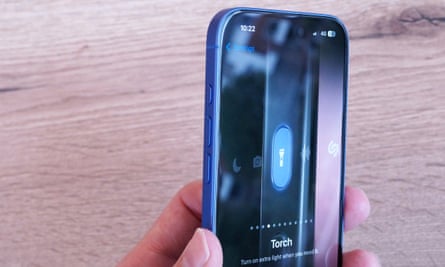 View image in fullscreenThe action button can mute the phone or turn on a focus mode, but I find setting it to turn on the torch the most useful. Photograph: Samuel Gibbs/The GuardianThe standard iPhone also has the same new camera control button as the 16 Pro, which quickly launches the camera, zooms and changes settings, and shoots photos.
View image in fullscreenThe action button can mute the phone or turn on a focus mode, but I find setting it to turn on the torch the most useful. Photograph: Samuel Gibbs/The GuardianThe standard iPhone also has the same new camera control button as the 16 Pro, which quickly launches the camera, zooms and changes settings, and shoots photos.
It runs iOS 18 but lacks Apple’s much-advertised AI features, which won’t arrive in beta as part of iOS 18.1 update until later in October in the US and December for the UK, Australia and other non-US English-speaking countries, while the rest of Europe is out of luck for the foreseeable future.
Specifications Screen: 6.1in Super Retina XDR (OLED) (460ppi)
Processor: Apple A18
RAM: 8GB
Storage: 128, 256 or 512GB
Operating system: iOS 18
Camera: 48MP main + 12MP UW; 12MP front-facing
Connectivity: 5G, wifi 7, NFC, Bluetooth 5.3, Thread, USB-C, Satellite, UWB and GNSS
Water resistance: IP68 (6 metres for 30 mins)
Dimensions: 147.6 x 71.6 x 7.8mm
Weight: 170g
Faster A18 chip with solid battery life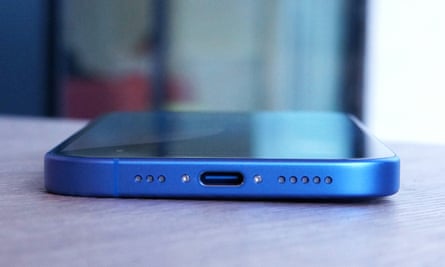 View image in fullscreenA full charge via USB-C with a 30W power adaptor takes just under 100 minutes, hitting 80% in 53 minutes. Photograph: Samuel Gibbs/The GuardianThe 16 has a new A18 chip at its heart, which is 30% faster than the two-year-old A16 used in its predecessor with 40% faster graphics. It feels snappier in operation and will stay fast for a long time, as well as enabling the imminent AI features.
View image in fullscreenA full charge via USB-C with a 30W power adaptor takes just under 100 minutes, hitting 80% in 53 minutes. Photograph: Samuel Gibbs/The GuardianThe 16 has a new A18 chip at its heart, which is 30% faster than the two-year-old A16 used in its predecessor with 40% faster graphics. It feels snappier in operation and will stay fast for a long time, as well as enabling the imminent AI features.
The chip is also more power efficient, which helps the 16 have very long battery life for a phone this size. It manages to last more than 48 hours between charges for general usage, including a mixture of 5G and wifi, while actively using the screen for more than seven hours. It should last through even the heaviest of days.
Sustainability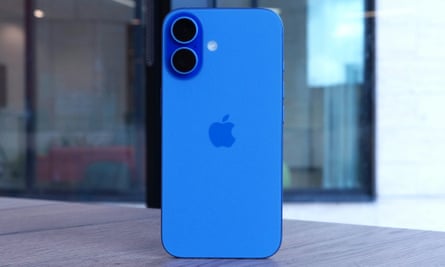 View image in fullscreenThe screen glass is 50% tougher than previous iPhones, according to Apple, but a case will still be needed to protect it and the back from drops. Photograph: Samuel Gibbs/The GuardianApple says the battery should last in excess of 1,000 full-charge cycles with at least 80% of its original capacity and can be replaced for £95. Out-of-warranty screen repairs cost £289. The 16 has repair guides available and was awarded seven out of 10 for repairability by specialists iFixit.
View image in fullscreenThe screen glass is 50% tougher than previous iPhones, according to Apple, but a case will still be needed to protect it and the back from drops. Photograph: Samuel Gibbs/The GuardianApple says the battery should last in excess of 1,000 full-charge cycles with at least 80% of its original capacity and can be replaced for £95. Out-of-warranty screen repairs cost £289. The 16 has repair guides available and was awarded seven out of 10 for repairability by specialists iFixit.
It contains more than 30% recycled material, including aluminium, cobalt, copper, gold, lithium, plastic, rare earth elements, steel, tin and tungsten. The company breaks down the phone’s environmental impact in its report. Apple offers trade-in and free recycling schemes, including for non-Apple products.
Camera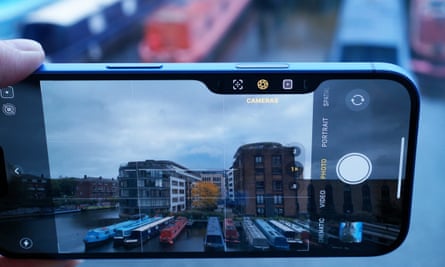 View image in fullscreenThe camera control button can switch cameras and zoom, adjust depth, exposure, styles and tone, and shoot photos with presses, clicks, swipes and scrolls with one finger. Photograph: Samuel Gibbs/The GuardianThe dual camera system on the back of the phone is broadly the same as last year’s model, including a 48MP main camera and a 12MP ultrawide, which can be controlled using touch or the new physical camera control button next to the power button.
View image in fullscreenThe camera control button can switch cameras and zoom, adjust depth, exposure, styles and tone, and shoot photos with presses, clicks, swipes and scrolls with one finger. Photograph: Samuel Gibbs/The GuardianThe dual camera system on the back of the phone is broadly the same as last year’s model, including a 48MP main camera and a 12MP ultrawide, which can be controlled using touch or the new physical camera control button next to the power button.
Main camera produces images that are great across a range of lighting conditions, while the 2x in-sensor zoom remains useful in good light but struggles a bit in duller conditions. The ultrawide now has autofocus and a slightly faster lens, producing better photos in dimmer environments. It also enables a macrophotography mode to shoot closeup images at up to 2cm away from the object – a fun feature that was limited to Apple’s Pro models until now.
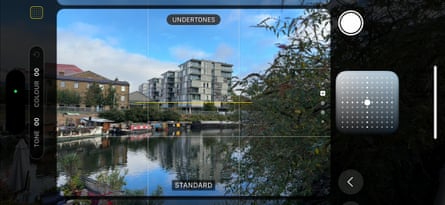 View image in fullscreenPhotographic styles can radically change the way the camera shoots photos and can be adjusted or changed after the fact. Illustration: Samuel Gibbs/The GuardianThe 16’s camera also has the interesting photographic styles feature from the 16 Pro, which works a bit like advanced filters adjusting the colour, tone and palette of photos either when shooting them or after the fact. The camera can also shoot spatial photos and videos for viewing on headsets such as the Vision Pro, and has the impressive audio mix feature for video from the 16 Pro.
View image in fullscreenPhotographic styles can radically change the way the camera shoots photos and can be adjusted or changed after the fact. Illustration: Samuel Gibbs/The GuardianThe 16’s camera also has the interesting photographic styles feature from the 16 Pro, which works a bit like advanced filters adjusting the colour, tone and palette of photos either when shooting them or after the fact. The camera can also shoot spatial photos and videos for viewing on headsets such as the Vision Pro, and has the impressive audio mix feature for video from the 16 Pro.
Overall, the 16’s camera does a good job in most conditions, but its lack of a telephoto camera holds it back against similarly priced Android rivals.
PriceThe iPhone 16 costs from £799 (€959/$799/A$1,399) with 128GB of storage.
For comparison, the iPhone 16 Plus costs £899, iPhone 16 Pro costs £999, the iPhone 16 Pro Max costs £1,199, the Google Pixel 9 Pro costs £999, the Samsung Galaxy S24 Ultra costs £1,249 and the Fairphone 5 costs £499.
VerdictThe iPhone 16 may not look that different from the last few iterations of Apple’s standard smartphone but it features a range of updates that make it more interesting than it appears on first glance.
The added action button from last year’s 15 Pro is genuinely useful for one-button access to your most used app or feature, such as the torch. The camera control button is equally useful for quickly opening the camera and shooting photos, even if it is a little fiddly to use to adjust settings with any accuracy.
The camera itself is solid, capturing great photos pretty easily. The new photographic styles feature and macrophotography are great fun for those that want to get creative. The lack of a real zoom camera, faster and less jerky screen, and always-on display is disappointing. They are features common to rivals but Apple keeps for the iPhone 16 Pro.
The much faster chip and solid two-day battery life are very welcome, and should help the iPhone 16 last longer before it needs service or replacing. It may not be the most exciting phone any more, but the iPhone 16 is a big jump up from five-year-old models and is ready to go the distance.
Pros: fast, good dual camera with macro mode, decent screen, great size, action button, camera control button, photographic styles, USB-C, great battery life, long software support, Face ID.
Cons: no telephoto camera, screen slower than competition and Pro iPhones, no always-on display mode, samey design.
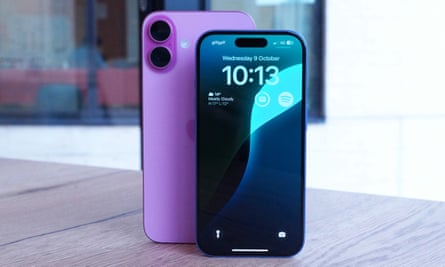 View image in fullscreenThe iPhone 16 (right) is a great size but for those who want a bigger version, the iPhone 16 Plus (left) offers the features with a larger screen. Photograph: Samuel Gibbs/The Guardian
View image in fullscreenThe iPhone 16 (right) is a great size but for those who want a bigger version, the iPhone 16 Plus (left) offers the features with a larger screen. Photograph: Samuel Gibbs/The Guardian